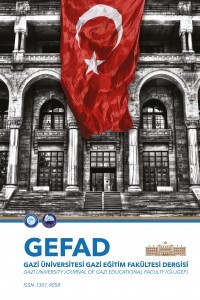Öğretmen Adaylarının Değişkenleri Belirleme ve Kontrol Etme Yeteneklerinin Geliştirilmesi
Bu çalışmada, sınıf öğretmenliği ana bilim dalı öğrencilerinin değişkenleri belirleme ve kontrol etme becerileri konusunda kullanılan kavramlar hakkındaki ön bilgi düzeylerinin incelenmesi ve değişkenleri belirleme ve kontrol becerilerini geliştirmek için seçilen iki öğretim yönteminin etkilerinin belirlenmesi amaçlanmıştır. Çalışmanın örneklemini sınıf öğretmenliği ana bilim dalı üçüncü sınıfta okuyan 96 öğrenci (kız=51, erkek=44) oluşturmaktadır. Öğrenciler Uygulama–1 (U-1) ve Uygulama-2 (U-2) olarak iki gruba ayrılmıştır. Her iki gruptaki öğrencilerin değişkenleri belirleme ve kontrol etme konusundaki ön bilgilerini ölçmek için Değişkenleri Belirleme-Kontrol Etme Yetenek Testi (DBKEYT) ön test olarak uygulanmıştır. Daha sonra değişkenleri belirleme ve kontrol etme becerilerini geliştirmek için U-1 gruThe purpose of this study is to investigate the pre-knowledge levels of Primary Education Department students on the concepts used for the skills of identifying and controlling variables and to compare the effectiveness of the two teaching methods employed in developing these skills. This study is applied to 96 third year students (girls:51, boys:44). The students are divided into two groups as Practice-1 (P-1), and Practice-2 (P-2). After the groups are formed, in order to determine the students\' pre knowledge on the subject of identifying and controlling variables, students in both groups are given a pre-test, which is called ‘The Skill Test to Identify and Control the Variables\' (TICVS). While the students in the first group complete the activities designed according to the inquiry teaching methods, the second group students complete the activities designed according to the experimentation techniques. After the students have finished Değişkenleri Belirleme ve Kontrol Etme, Araştırma yoluyla Öğretim Metodu, Gösteri Deneyleri TekniğiIdentification and Control of the Variables, Inquiry Method, Demonstrative Experimentation Technique. Tam Metin
Anahtar Kelimeler:
Değişkenleri Belirleme ve Kontrol Etme, Araştırma yoluyla Öğretim Metodu, Gösteri Deneyleri Tekniği
Developing Teacher Candidates Skills of Identifying and Controlling Variables
The purpose of this study is to investigate the pre-knowledge levels of Primary Education Department students on the concepts used for the skills of identifying and controlling variables and to compare the effectiveness of the two teaching methods employed in developing these skills. This study is applied to 96 third year students (girls:51, boys:44). The students are divided into two groups as Practice-1 (P-1), and Practice-2 (P-2). After the groups are formed, in order to determine the students\' pre knowledge on the subject of identifying and controlling variables, students in both groups are given a pre-test, which is called ‘The Skill Test to Identify and Control the Variables\' (TICVS). While the students in the first group complete the activities designed according to the inquiry teaching methods, the second group students complete the activities designed according to the experimentation techniques. After the students have finished Değişkenleri Belirleme ve Kontrol Etme, Araştırma yoluyla Öğretim Metodu, Gösteri Deneyleri TekniğiIdentification and Control of the Variables, Inquiry Method, Demonstrative Experimentation Technique. Tam Metin
Keywords:
Identification and Control of the Variables, Inquiry Method, Demonstrative Experimentation Technique.,
___
- Arena, Paul (1996). The role of relevance in the acquisition of science process skills. Australian Science Teachers Journal, 42, 34-39.
- Ateş, S. & Bahar, M. (2002). Araştırmacı Fen Öğretimi Yaklaşımıyla Sınıf Öğretmenliği 3. Sınıf Öğrencilerinin Bilimsel Yöntem Yeteneklerinin Geliştirilmesi. V. Ulusal Fen Bilimleri ve Matematik Eğitimi Kongresi. 16-18 Eylül 2002. ODTÜ, Ankara.
- Brotheton, P. N. & Preece, P.F.W (1995). Science process skills: Their nature and interrelationships. Research in Science & Technological Education, 13, 5-12.
- Burns, J. C., Okey, J. R., and Wise K. C. (1985). Development of an integrated process skill test: TIPS II. Journal of Research in Science Teaching, 22, 169-177.
- Department of Education and Science (1991). Science in the National Curriculum, London, HMSO.
- Ebenezer, J. V. & Haggerty, S. M. (1999). Becoming a Secondary School Science Teacher. Columbus, OH: Prentice-Hall Inc.
- Germann, P. J. & Odom, A. L. (1996). Student performance on asking questions, identifying variable, and formulating hypothesis. School Science & Mathematics, 96, 192-201.
- Griffiths, A. K. & Thompson, J. (1993). Secondary school students’ understandings of scientific processes: An interview study. Research in Science & Technological Education, 11, 15-26.
- Hackling, M. W. & Garnett, P. J. (1995). The development of expertise in science investigation skills. Australian Science Teacher Journal, 41, 80-86.
- Jackson, D. F., Edwards, B. J., & Berger, C. F. (1993). Teaching the design and interpretation of graphs through computer-aided graphical data analysis. Journal of Research in Science Teaching, 30(5), 483-501.
- Lawson, Anton E. (1995). Science Teaching and Development of Thinking. Belmont, CL: Wadswortd Publishing Company.
- Lawson, A. E. (2001). Using the learning cycle to teach biology concepts and reasoning patterns. Journal of Biological Education, 35, pp. 165-168.
- Moore, K. D. (1999). Middle and Secondary School Instructional Methods. New York, NY, USA: McGraw-Hill College
- National Research Council. (1996). National Science Education Standards. Washington, DC: National Academy of Sciences.
- Ross, A. (1987). How does information retrieval help children’s learning? In Ann J. and Peter S. (Eds.), Computers in Education, 5-13. Milton Keynes, Philadelphia: Open University.
- Roth. W. M. & Roychounhury, A. (1993). Development of science process skills in authentic contexts. Journal of Research in Science Teaching, 30, 127-152.
- Tobin, K. G., & Capie, W. (1981). Development and validation of a group test of logical thinking. Educational and Phychological Measurement, 41, 413-23.
- ISSN: 1301-9058
- Yayın Aralığı: Yılda 3 Sayı
- Başlangıç: 1985
- Yayıncı: Gazi Üniversitesi
Sayıdaki Diğer Makaleler
Etkili Öğretmen Yetiştirme Açısından Okul Deneyimi Derslerinin Değerlendirilmesi
İlköğretim Sosyal Bilgiler Dersinde Deprem Eğitiminin Değerlendirilmesi
Öğretmen Adaylarının Değişkenleri Belirleme ve Kontrol Etme Yeteneklerinin Geliştirilmesi
İlköğretim Okulu Öğrencileri Kötü Yapılandırılmış Problemleri Nasıl Çözüyor
İşlevsel Piyano Becerilerinin Müzik Öğretmenleri İçin Önemi
Bolu İlinde Turizmi Etkileyen Faktörler İle Doğal, Tarihi Ve Kültürel Turizm Değerleri
Yerli ve Yabancı Turistlerin Türk Mutfağı Hakkındaki Görüşleri
